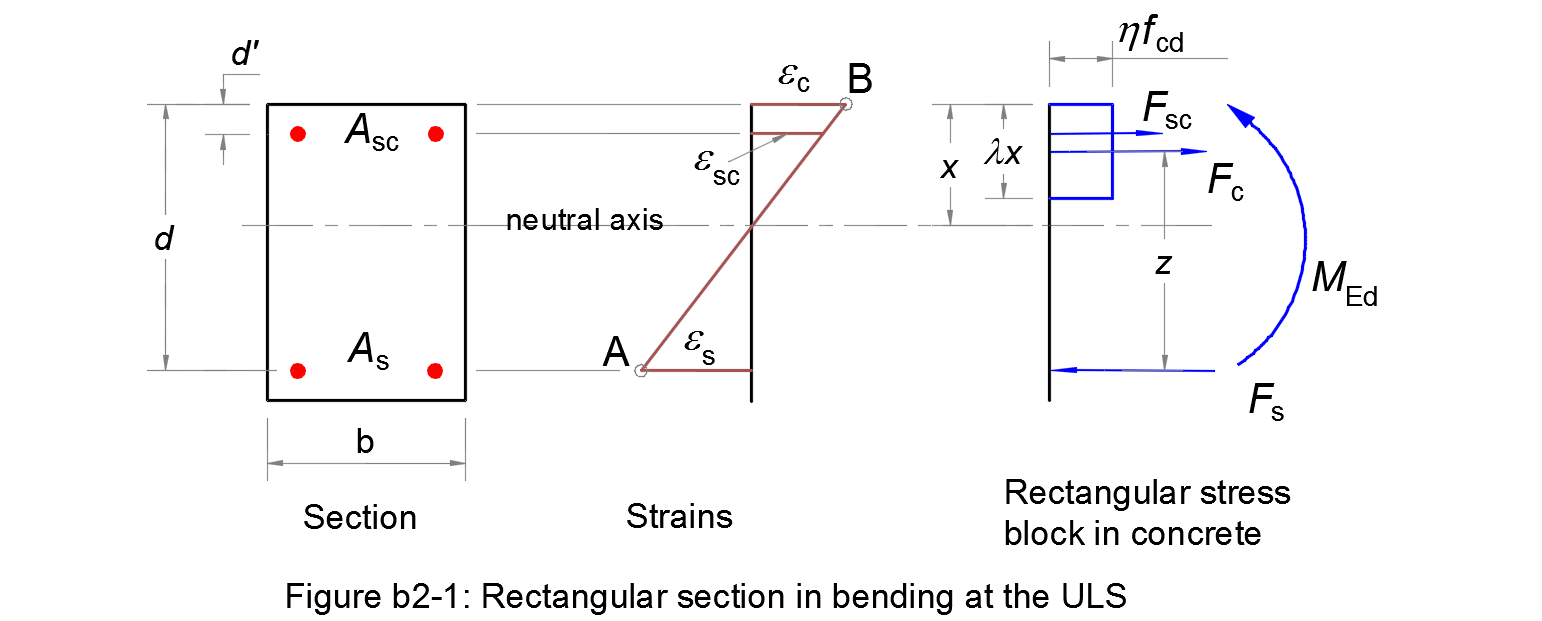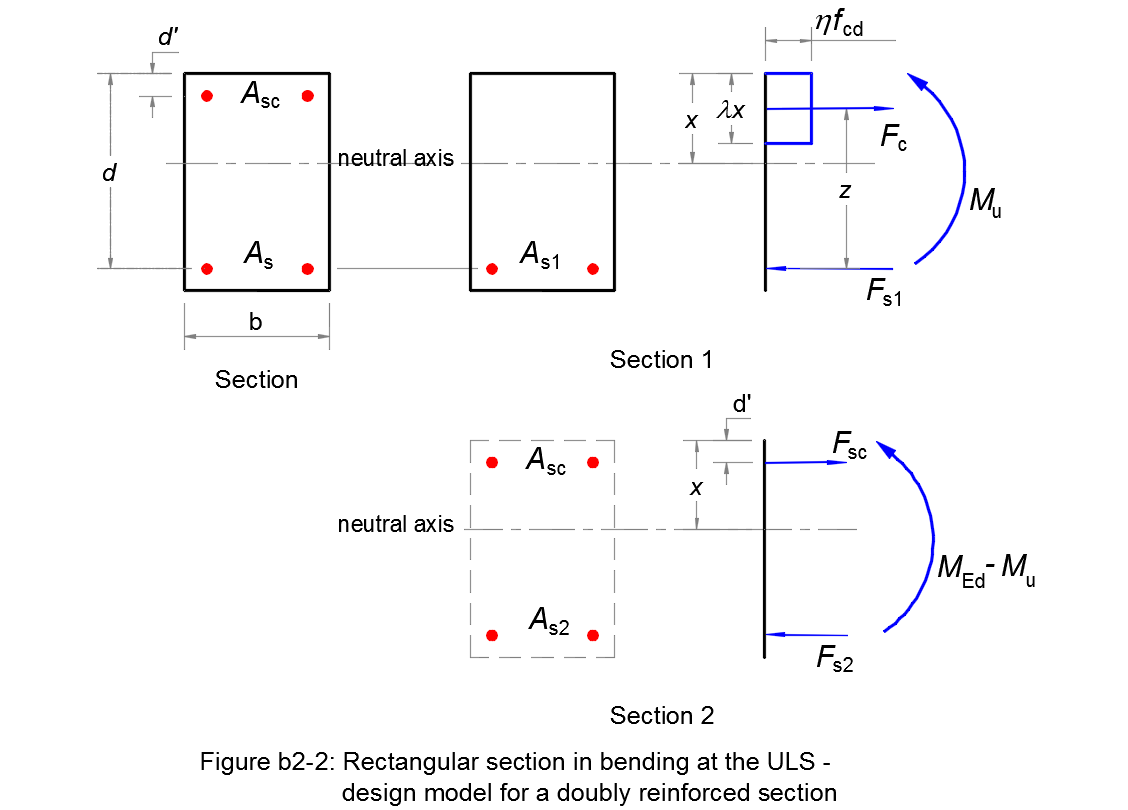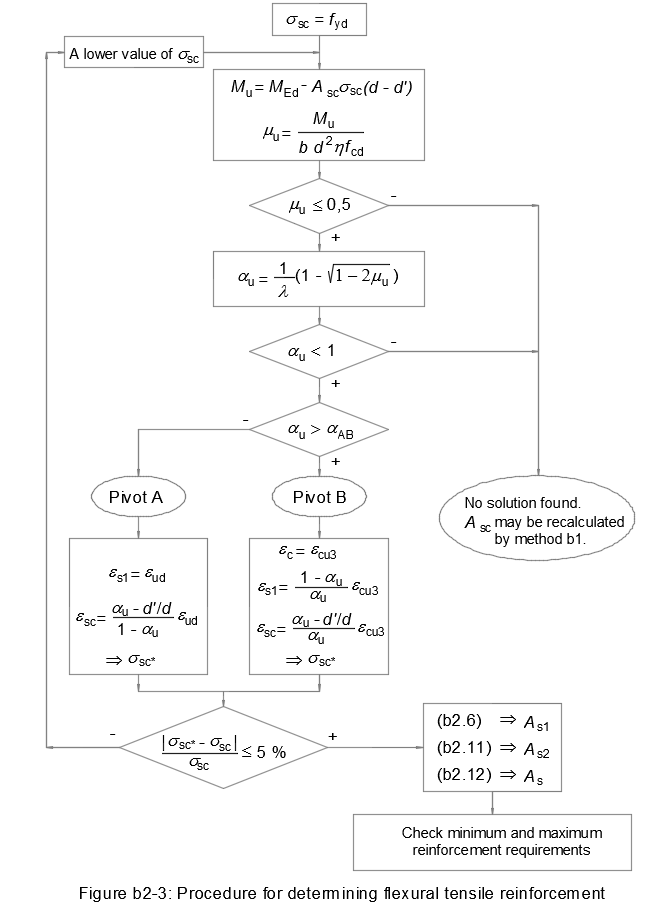b2. Design method for tensile reinforcement of a rectangular section in bending at the ULS with known compressive reinforcement, As
Eurocode 2 - Design of concrete sections

Assumptions
1. Plane sections remain plane after straining, so that there is a linear distribution of strains across the section.
2. Reinforcing steels have the same deformation as the nearby concrete.
3. The tensile strength of concrete is ignored.
4. A rectangular distribution of the compressive stress in the concrete is assumed, see 3.1.7 (3).
5. The ultimate limit state occurs when the strain in the reinforcing steel reaches the limit εud (Pivot A) and/or the strain in the concrete reaches the limit εcu3 (Pivot B).
Considering the depth of the neutral axis/the effective depth of the cross-section:
| αu = x/d | (b2.1) |
The linear distribution of strains gives:
| αu = εc/(εc + εs) | (b2.2) |
Balanced section AB
We consider a balanced section for which the Pivot A and Pivot B are reached at the same time: εc = εcu3 and εs = εud.
For the balanced section, calculating:
| αAB = εcu3/(εcu3 + εud) | (b2.3) |
If αu > αAB ⇔ the Pivot B is reached first. Otherwise, the Pivot A is reached first.
Two fictive sections
Considering that the section is an overlap of two fictive sections (see Figure b2-2):
- One concrete section with only a tensile reinforcement As1;
- One section with only two reinforcements As2 and Asc.

Iterative calculation of the stress σsc
Assumimg the stress in the compressive reinforcement σsc = fyd.
The bending moment Mu supported by the section without compression reinforcement:
| Mu = MEd - Asc σsc (d - d') | (b2.4) |
For equilibrium, this bending moment must be balanced by the moment of resistance of the section:
| Mu = Fc z = b η fcd λ x (d - λ x/2) | (b2.5) |
| Mu = Fs z = As1 σs (1 - λ αu /2) d ⇔ As1 = Mu /[(1 - λ αu /2) d σs] | (b2.6) |
Substituting the following in (b2.5):
| μu = Mu /(b d2 η fcd) | (b2.7) |
(b2.5) ⇒ 2 μu = 2 λ (x/d) - λ2 (x/d)2
|
⇔ 2 μu = 2 λ (αu) - λ2 (αu)2 |
(b2.8) |
If μu ≤ 0,5, this quadratic equation has a solution:
| αu = [1 - (1 - 2μu)0.5] /λ | (b2.9) |
• αu ≤ αAB ⇒ Pivot A
The strain in the tensile reinforcement εs1 = εud.
The strain diagram ⇒ the strain in the compression reinforcement εsc = εud⋅(αu - d/d')/(1 - αu).
• αu > αAB ⇒ Pivot B
The strain in the concrete εc = εcu3.
The strain diagram ⇒ the strain in the compression reinforcement εsc = εcu3⋅(αu - d/d')/αu.
By reading the design stress-strain diagram for reinforcing steel ⇒ the stress in the compressive reinforcement σsc*.
This calculated value of σsc* must be compared with the initial value σsc. If the difference is greater than 5 %, we start over with a lower value of σsc. If the difference is lower than or equal to 5 %, we accept the initial value σsc as the stress in the compressive reinforcement.
Reinforcement As1
For the first fictive section without compression steel, the strain in the tensile reinforcement εs1 is equal to εud in case of Pivot A, is equal to εcu3⋅(1 - αu)/αu in case of Pivot B.
From the design stress-strain diagram for reinforcing steel ⇒ the stress in the tensile reinforcement σs.
(b2.6) ⇒ the tensile reinforcement As1 = Mu /[(1 - λ αu /2) d σs].
Reinforcement As2
The second fictive section at equilibrium gives:
| As2 = Asc σsc /σs2 | (b2.10) |
Finally, the total tensile reinforcement is:
| As = As1 + As2 | (b2.11) |
Flowchart
Figure b2-3 resumes this design method for a rectangular reinforced concrete section in bending at the ULS with known compressive reinforcement:

